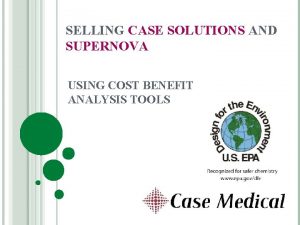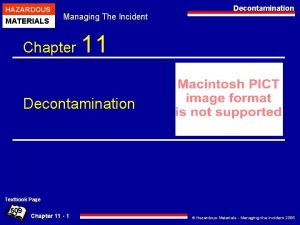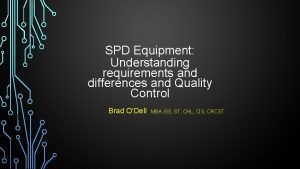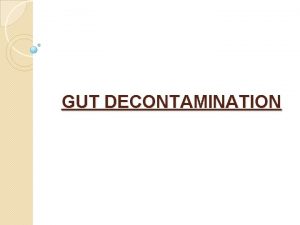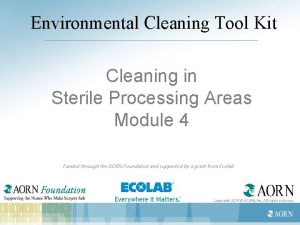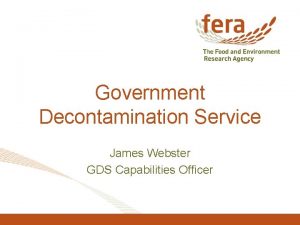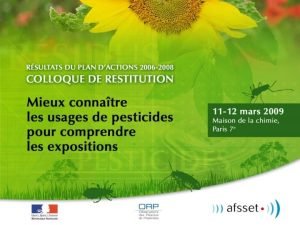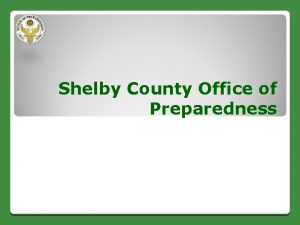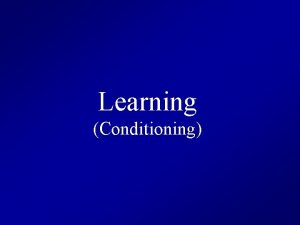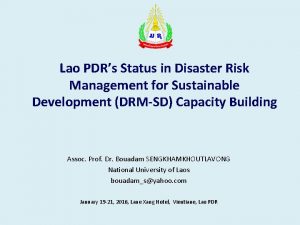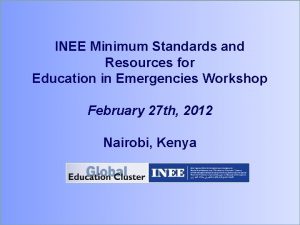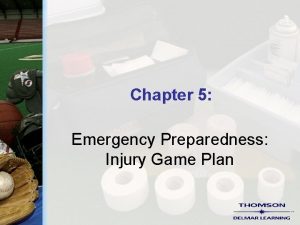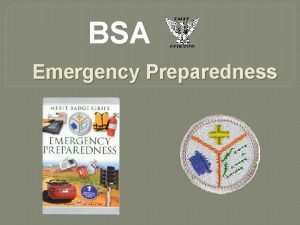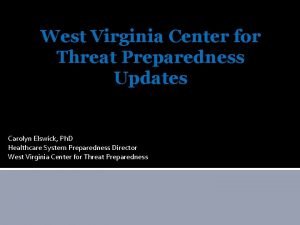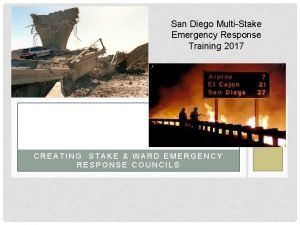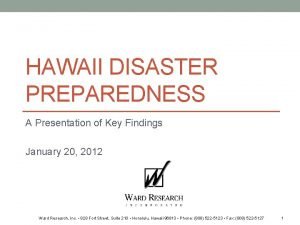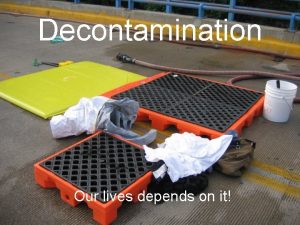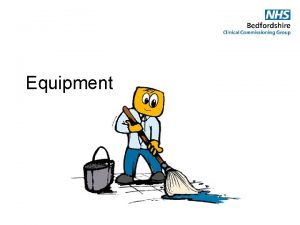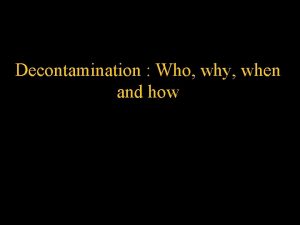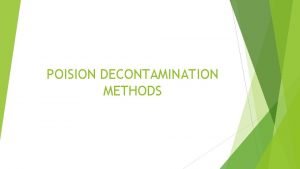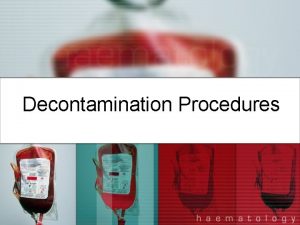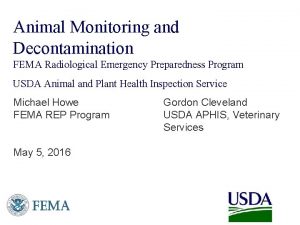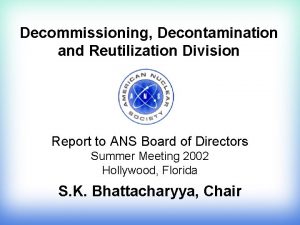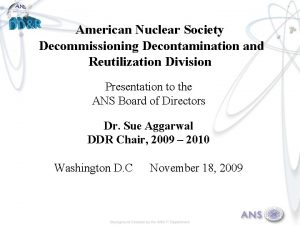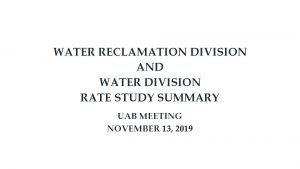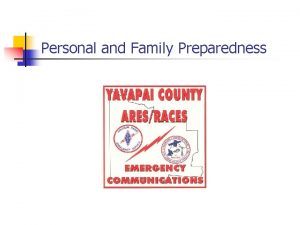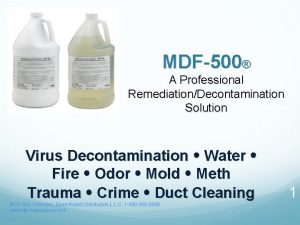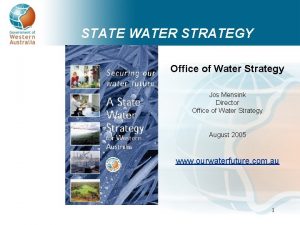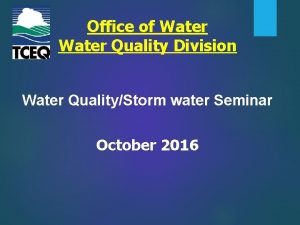Decontamination Preparedness and Assessment Strategy Water Security Division

































- Slides: 33

Decontamination Preparedness and Assessment Strategy Water Security Division ASDWA Webinar Series for the State Security Coordinators August 23, 2017

Outline Explain the purpose and benefits of the Decontamination Preparedness and Assessment Strategy Provide Tool Overview State- EPA Partnerships 2

Think About this…. Do utilities in your state incorporate the remediation process in their Emergency Response Plan (ERP)? 3

Decontamination Preparedness and Assessment Strategy (DPAS) • Designed as a interactive preparedness tool • Provides information on the remediation process of a contamination event at a water utility • Provides an efficient process for utilities to address the complexities of remediation 4

DPAS Includes: • Information on water and wastewater treatment and infrastructure decontamination • Worksheets, checklists and other resources to aid the remediation process • Information on key statutes and regulations relevant to remediation. • The principal roles and responsibilities to increase understanding of the Incident Command System (ICS) 5

DPAS - Benefits for States and Utilities v Explains the steps involved in the remediation process v Provides utilities with a printable strategy, including actions that can be taken prior to an event to increase preparedness v Provides a list of resources and other tools available to help prepare for an event v Provides an overview of statutes and regulations applicable to contamination incidents v Provides an overview of important public health and environmental safety considerations during an remediation event. 6

OVERVIEW OF DECONTAMINATION PREPAREDNESS AND ASSESSMENT STRATEGY (DPAS) 7

Determine Clearance Goals Develop Characterization Strategy Implement Characterization Strategy Select Treatment and Decontamination Methods Develop Treatment and Decontamination Strategy Implement Water Treatment Strategy Implement Infrastructure Decontamination Strategy Recovery 3. Clearance Characterize the Impact of the Contamination Remediation 2. Decontamination 1. Characterization DPAS Overview Confirmed Contamination Develop and Implement the Clearance Strategy Complete Extensive Evaluation of Strategy Results Finalize Remediation Activities Complete Incident Report and Perform After-Action Review 8

Characterization Phase Key Decisions q What is the extent of the contamination? q Is treatment needed? 9

Characterization Phase 1. Characterize the Impact of the Contamination 2. Determine Clearance Goals 3. Develop Characterization Strategy 4. Implement Characterization Strategy 10

Characterization Phase Decision Framework Proceed to Clearance Proceed Phase to Decontamination Phase 4. Is natural attenuation adequate to eliminate the public health impacts based on exposure assessment, water and infrastructure impacted, contaminant information, and effectiveness of public notification? NO YES 11

Determine Clearance Goals Develop Characterization Strategy Implement Characterization Strategy Select Treatment and Decontamination Methods Develop Treatment and Decontamination Strategy Implement Water Treatment Strategy Implement Infrastructure Decontamination Strategy Recovery 3. Clearance Characterize the Impact of the Contamination Remediation 2. Decontamination 1. Characterization DPAS Overview Confirmed Contamination Develop and Implement the Clearance Strategy Complete Extensive Evaluation of Strategy Results Finalize Remediation Activities Complete Incident Report and Perform After-Action Review 12

Decontamination Phase Key Decisions q What treatment should be implemented? q Is infrastructure decontamination necessary? q Is remediation verification criteria attained? 13

Decontamination Phase 1. Identify Options and Select Water or Wastewater Treatment Methods 2. Develop Water or Wastewater Treatment Strategy 3. Implement Water or Wastewater Treatment Strategy 4. Develop and Implement Infrastructure Decontamination Strategy 14

Decontamination Phase Decision Framework Proceed to Clearance Phase Remediation verification criteria attained? YES Are clearance goals met? YES NO 4. Develop and Implement Infrastructure Decontamination Strategy 15

Determine Clearance Goals Develop Characterization Strategy Implement Characterization Strategy Select Treatment and Decontamination Methods Develop Treatment and Decontamination Strategy Implement Water Treatment Strategy Implement Infrastructure Decontamination Strategy Recovery 3. Clearance Characterize the Impact of the Contamination Remediation 2. Decontamination 1. Characterization DPAS Overview Confirmed Contamination Develop and Implement the Clearance Strategy Complete Extensive Evaluation of Strategy Results Finalize Remediation Activities Complete Incident Report and Perform After-Action Review 16

Clearance Phase Key Decisions q Have the clearance goals been met? q What incident reports need to be completed and records retained? 17

1. Develop and Implement the Clearance Strategy Clearance Phase 2. Evaluate Results and Decide if the System Has Been Cleared 3. Develop and Implement Final Remediation Activities 4. Complete Incident Report and Perform After-Action Review 18

Clearance Phase Decision Framework Have the clearance goals been met? YES Are there other concerns, such as aesthetic issues or public perception? NO Decision “not cleared” Could the Clearance Goals be too strict? Decision “cleared” 19

ADDITIONAL FEATURES OF DPAS

Incident Command System Structure 21

22 Preparedness Checklist

23 Decision-Making Framework Checklist

Case Studies Objective is to highlight challenges and the approaches utilities take during the remediation process. Ø Case Study 1 − Drinking water plant affected − Highlight the complexity of the determination of clearance goals and agency (e. g. , CDC and the Public Health Department) roles Ø Case Study 2 − Wastewater treatment plant affected − Highlight the benefits of developing an SAP 24

SCENARIO DEMO

Scenario ØA utility confirmed gasoline contamination within the finished water storage tank located within the distribution system. ØOdor in water and consumer complaints led to identification of gasoline contamination at the 200, 000 gallon ground level finished water storage tank. ØConfirmed high concentration in storage tank and lower concentration in distribution system 26

27

28

29

STATE- EPA PARTNERSHIP 30

States- What Can you Do? q Promote the strategy to utilities/partners q Provide support to utilities as they develop plans § e. g. , Standard Operating Procedures, Waste Management Plan, Sampling Analysis Plan, Remediation Action Plan, etc. q Identify additional resources that can aid utilities during the remediation process q Identify trainings & opportunities for utilities § Encourage and participate in emergency preparedness training and exercises § Provide continuing education credits (CEUs) 31

EPA’s Next Steps • Finalize Strategy – Tentative Fall Publication • Partner with states and EPA regions to promote the strategy • Partner with states and other stakeholders (NRWA, RCAP, AWWA Sections, etc. ) to assist small/ medium size utilities • Conduct DPAS training 32

Contact Information For more information on the Decontamination Strategy, please contact: Marissa Lynch, U. S. EPA Environmental Engineer Office of Ground Water and Drinking Water Phone: (202) 564 -2761 Email: lynch. marissa@epa. gov Veronica Aponte-Morales, U. S. EPA ORISE Research Fellow - Environmental Engineer Office of Ground Water and Drinking Water Phone: (202) 564 -4663 E-Mail: aponte-morales. veronica@epa. gov 33
 Water and water and water water
Water and water and water water Steris decontamination sinks
Steris decontamination sinks Contamination vs cross contamination
Contamination vs cross contamination Steelco decontamination equipment
Steelco decontamination equipment Gut decontamination
Gut decontamination Sterile processing decontamination ppe
Sterile processing decontamination ppe Government decontamination service
Government decontamination service Sphair decontamination
Sphair decontamination Private securit
Private securit Chapter 36 emergency preparedness and protective practices
Chapter 36 emergency preparedness and protective practices Chapter 36 emergency preparedness and protective practices
Chapter 36 emergency preparedness and protective practices What are disasters
What are disasters 369 times 2
369 times 2 Short form of division
Short form of division How to use synthetic division
How to use synthetic division Polynomial synthetic division
Polynomial synthetic division What is learning
What is learning Shelby county office of preparedness
Shelby county office of preparedness Biological preparedness
Biological preparedness Biological preparedness
Biological preparedness Conclusion in disaster management
Conclusion in disaster management Preparedness mitigation response recovery
Preparedness mitigation response recovery Biological preparedness
Biological preparedness Promoting family earthquake preparedness
Promoting family earthquake preparedness Data breach preparedness
Data breach preparedness Operant conditioning
Operant conditioning Chapter 5 emergency preparedness injury game plan
Chapter 5 emergency preparedness injury game plan Bsa emergency preparedness
Bsa emergency preparedness West virginia center for threat preparedness
West virginia center for threat preparedness National radiological emergency preparedness conference
National radiological emergency preparedness conference Stake emergency preparedness plan
Stake emergency preparedness plan Who pip framework
Who pip framework Nfpa 1600
Nfpa 1600 Hawaii disaster preparedness
Hawaii disaster preparedness

